
| SITUATION | PILLARS | EXCAVATION | IMBRICATED | GROOVED | RIPPLED | BOSSED | PLAIN | OTHER |
Notes on the Il Lokeridede Pillar Site
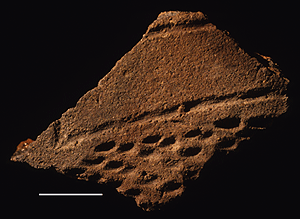
The Use of Exterior Grooving at Il Lokeridede
white bar = 1 cm.
None of the sherds on this page have internal decoration.
Since empty panels are very uncommon at Nderit sites, the decoration on this sherd is likely to be from an undecorated zig-zag band bounded by grooves that separate it from panels, in this case filled with oval stylus (or possibly comb) impressions arranged in an open grid. The grooves are made by a technique called "card grooving" in which the groove is produced by drawing the narrow edge of a stylus or a flat object with a card-like edge along a little bit at a time, producing a grove of end-to-end dashes. Card grooving is extremely uncommon in Nderit assemblages, but common in Ileret assemblages.
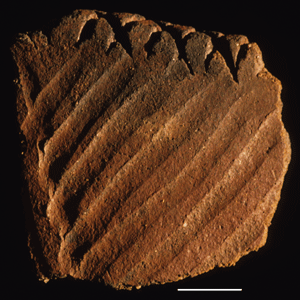
This sherd is unslipped and unburnished. It is decorated with panels of widely spaced, canted grooves that are broad and u-shaped. Here we can see that the boundary groove in the adjoining panel has been completely overrun by the the grooves at the right, which were pulled downward from the rim.
The rim, itself, is decorated with a crosshatch of deeply cult grooves.
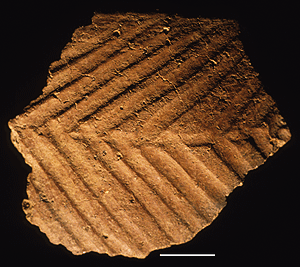
This rim sherd is unslipped and unburnished. First a boundary groove was laid down about 2.5 cm. below the rim. Diagonal grooves were then laid down, beginning at the rim and terminating at the boundary groove. In the band below the boundary groove, the grooves were made by pulling upward, terminating at the boundary groove and sometimes intruding into the grooves at the bottom of the upper band.
Notice the cracking in the surface in the area below the rim. This may be due to rapid cooling of the pot or to insufficient temper. Many of the softer paste vessels have this problem and would never survive long if exposed on the surface of the ground. Rapid burial in a friendly sediment is a requirement for their survival in the archaeological record.

It looks as though the grooved panels on this sherd have been rolled out and flattened to give them a more sine-like cross section. Then there has been some casual vertical burnishing with the implement being pulled downward from the vicinity of the rim. Since it is incomplete and variable, it may be accidental, done while handling the vessel when the clay body was still easily modified.

The rim displays a crosshatched design of deeply cut grooves.
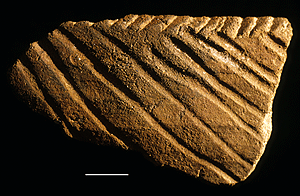
This sherd is unslipped and unburnished. The vessel was scraped parallel to the rim before it was decorated, leaving the surface porous and coarse in texture. The grooves are narrow and irregular, with a u-shaped cross section.
The rim was decorated by impressing the margin of a stylus in overlapping steps.

This is an interesting sherd because of the elaborate decorative strategy that it reveals. The vessel was first grooved with panels, including ones like these that were butted end-to-end. The vessel was slipped; probably self-slipped. The grooves were burnished, leaving sharp ridges between. Then bands of grooves were impressed with stylus imbrication, with one row of impressions per groove. You can see how the contour of the grooves were followed. By impressing the stylus within grooves, it was possible to produce very deep, canted impressions without displacing much of the clay body, producing a design of sharp definition and great relief. The grooves between the bands of impressions were then re-burnished with a broader implement that flattened out the ridges between the grooves and produced a tiny overhand along the shoulders of each groove, caught as tiny shadows in this photograph. Where the grooved panels butt together, this re-burnishing has been left incomplete so you can see what the upper grooves looked like after the first round of burnishing.
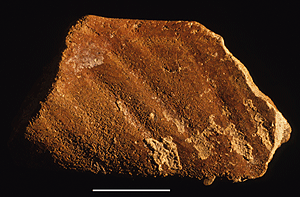
There are some vessel forms in Nderit Ware in which portions of the rim are folded in towards the center of the vessel and other portions folded outward. In some cases this is an enhancement to vessel shape, but in others the folded areas are turned into spouts or handles of various kinds. This rim sherd comes from such a vessel; it looks like we are headed for a spout on the left hand side.
this sherd shows the vessel was grooved, slipped with a pigmented slip and then burnished. It has suffered from both weathering at the surface along the bottom margin and from chemical weathering promoted in part by the dissolution of much of the shell temper close to the surface.

Burnished with a pigmented slip. This fragment could be part of a vessel base (though it is thin for a pointed base), a spout, or the top of a closed jar. The vessel was burnished, deeply grooved, and then over-burnished. Notice how the over-burnishing bends over the grooves in a lesser arc. Since burnishing is usually done parallel to the vessel rim, this implies that the sherd is from a spout, with the burnishing bending above and below the neck of the spout. In Nderit Ware, jars, when burnished, are typically prepared all the way up to the rim.

Highly burnished, red pigmented slip. The body exhibits classic burnished ripples that have then been heavily over-slipped and over-burnished. The neck of this large, closed jar has been decorated with deep grooves. The grooves were added after the the burnishing was complete and are crisply defined in comparison to the undulating surface of the lower neck and body.
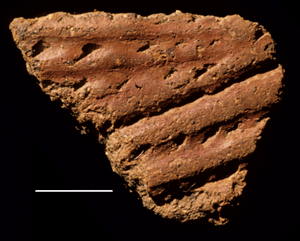
On this sherd, panels of grooves were produced, widely spaced stylus impressions added in the grooves, the vessel was slipped, and the grooves were reburnished, all but obliterating the impressions, except at field boundaries where the bounding groove and its deep impressions were left unaltered.

This sherd is unslipped and unburnished. The decoration consists of bands of cut grooves that have been made by an implement that has one flat surface that intersects with a convex surface, forming a sharp, ovate edge when seen in plan view. This "knife" is inserted and than folded away in the direction of its convex surface. This pushes up the clay body on the curved edge of the cut (see the three cuts on the left), leaving the opposite edge crisp and straight.
This form of decoration is uncommon in Nderit Ware assemblages, but fairly common is later wares in the Turkana Basin.
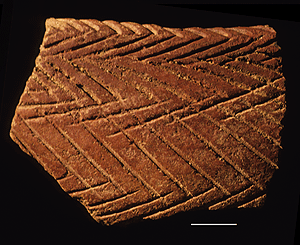
This sherd has a burnished, pigmented slip. After burnishing, a narrow implement was used to cut sharp-edged, narrow grooves in a zig-zag pattern. Notice the wide overlap between two of the bands that forms a band of rectangles at their intersection.
All Il Lokeridede web pages on this site
© 2008 by Charles M. Nelson
all rights reserved